Attached Macroinvertebrates Inhabiting Marine Plastic Debris from the Beach and Port Areas of the Southern Sea of Korea
Abstract
1. Introduction
2. Materials and Methods
2.1. Study Area
2.2. Plastic Litter Sorting
2.3. Sampling
2.4. Cluster Analysis
3. Results
3.1. Attached Macroinvertebrates in MPD Materials
3.2. Attached Macroinvertebrates Appearance
3.3. Attached Macroinvertebrates Cluster Analysis
4. Discussion
5. Conclusions
Author Contributions
Funding
Institutional Review Board Statement
Informed Consent Statement
Data Availability Statement
Acknowledgments
Conflicts of Interest
References
- Macfadyen, G.; Huntington, T.; Cappell, R. Abandoned, Lost or Otherwise Discarded Fishing Gear; FAO Consutlants, Lymington. United Kingdom of Great Britain and Northern Ireland; FAO: Rome, Italy, 2009; Volume 523. [Google Scholar]
- Jambeck, J.R.; Geyer, R.; Wilcox, C.; Siegler, T.R.; Perryman, M.; Andrady, A.; Narayan, R.; Law, K.L. Plastic Waste Inputs from Land into the Ocean. Science 2015, 347, 768–771. [Google Scholar] [CrossRef] [PubMed]
- Deudero, S.; Alomar, C. Mediterranean Marine Biodiversity under Threat: Reviewing Influence of Marine Litter on Species. Mar. Pollut. Bull. 2015, 98, 58–68. [Google Scholar] [CrossRef]
- Yu, P.; Liu, Z.; Wu, D.; Chen, M.; Lv, W.; Zhao, Y. Accumulation of Polystyrene Microplastics in Juvenile Eriocheir Sinensis and Oxidative Stress Effects in the Liver. Aquat. Toxicol. 2018, 200, 28–36. [Google Scholar] [CrossRef] [PubMed]
- Liu, Z.; Yu, P.; Cai, M.; Wu, D.; Zhang, M.; Chen, M.; Zhao, Y. Effects of Microplastics on the Innate Immunity and Intestinal Microflora of Juvenile Eriocheir Sinensis. Sci. Total Environ. 2019, 685, 836–846. [Google Scholar] [CrossRef] [PubMed]
- Haram, L.E.; Carlton, J.T.; Centurioni, L.; Crowley, M.; Hafner, J.; Maximenko, N.; Murray, C.C.; Shcherbina, A.Y.; Hormann, V.; Wright, C.; et al. Emergence of a Neopelagic Community through the Establishment of Coastal Species on the High Seas. Nat. Commun. 2021, 12, 6885. [Google Scholar] [CrossRef]
- Carlton, J.T.; Chapman, J.W.; Geller, J.B.; Miller, J.A.; Carlton, D.A.; McCuller, M.I.; Treneman, N.C.; Steves, B.P.; Ruiz, G.M. Tsunami-Driven Rafting: Transoceanic Species Dispersal and Implications for Marine Biogeography. Science 2017, 357, 1402–1406. [Google Scholar] [CrossRef]
- Rech, S.; Borrell, Y.; García-Vazquez, E. Marine Litter as a Vector for Non-Native Species: What We Need to Know. Mar. Pollut. Bull. 2016, 113, 40–43. [Google Scholar] [CrossRef]
- Carlton, J.T.; Fowler, A.E. Ocean Rafting and Marine Debris: A Broader Vector Menu Requires a Greater Appetite for Invasion Biology Research Support. Aquat. Invasions 2018, 13, 11–15. [Google Scholar] [CrossRef]
- Al-Khayat, J.A.; Veerasingam, S.; Aboobacker, V.M.; Vethamony, P. Hitchhiking of Encrusting Organisms on Floating Marine Debris along the West Coast of Qatar, Arabian/Persian Gulf. Sci. Total Environ. 2021, 776, 145985. [Google Scholar] [CrossRef]
- Zhou, C.; Liu, X.; Wang, Z.; Yang, T.; Shi, L.; Wang, L.; You, S.; Li, M.; Zhang, C. Assessment of Marine Debris in Beaches or Seawaters around the China Seas and Coastal Provinces. Waste Manag. 2016, 48, 652–660. [Google Scholar] [CrossRef]
- Murray, C.C.; Maximenko, N.; Lippiatt, S. The Influx of Marine Debris from the Great Japan Tsunami of 2011 to North American Shorelines. Mar. Pollut. Bull. 2018, 132, 26–32. [Google Scholar] [CrossRef] [PubMed]
- Miralles, L.; Gomez-Agenjo, M.; Rayon-Viña, F.; Gyraitė, G.; Garcia-Vazquez, E. Alert Calling in Port Areas: Marine Litter as Possible Secondary Dispersal Vector for Hitchhiking Invasive Species. J. Nat. Conserv. 2018, 42, 12–18. [Google Scholar] [CrossRef]
- Goldstein, M.C.; Carson, H.S.; Eriksen, M. Relationship of Diversity and Habitat Area in North Pacific Plastic-Associated Rafting Communities. Mar. Biol. 2014, 161, 1441–1453. [Google Scholar] [CrossRef]
- Ruiz, G.M.; Fofonoff, P.; Hines, A.H.; Grosholz, E.D. Non-Indigenous Species as Stressors in Estuarine and Marine Communities: Assessing Invasion Impacts and Interactions. Limnol. Oceanogr. 1999, 44, 950–972. [Google Scholar] [CrossRef]
- Occhipinti-Ambrogi, A. Global Change and Marine Communities: Alien Species and Climate Change. Mar. Pollut. Bull. 2007, 55, 342–352. [Google Scholar] [CrossRef]
- Gil, M.A.; Pfaller, J.B. Oceanic Barnacles Act as Foundation Species on Plastic Debris: Implications for Marine Dispersal. Sci. Rep. 2016, 6, 6–12. [Google Scholar] [CrossRef]
- Mesaglio, T.P.; Schilling, H.T.; Adler, L.; Ahyong, S.T.; Maslen, B.; Suthers, I.M. The Ecology of Lepas-Based Biofouling Communities on Moored and Drifting Objects, with Applications for Marine Forensic Science. Mar. Biol. 2021, 168, 21. [Google Scholar] [CrossRef]
- Aliani, S.; Molcard, A. Hitch-Hiking on Floating Marine Debris: Macrobenthic Species in the Western Mediterranean Sea. In Migrations and Dispersal of Marine Organisms; Springer: Dordrecht, The Netherlands, 2003; Volume 503, pp. 59–67. [Google Scholar]
- Liu, Z.; Chen, M.; Li, Y.; Huang, Y.; Fan, B.; Lv, W.; Yu, P.; Wu, D.; Zhao, Y. Different Effects of Reclamation Methods on Macrobenthos Community Structure in the Yangtze Estuary, China. Mar. Pollut. Bull. 2018, 127, 429–436. [Google Scholar] [CrossRef]
- Lv, W.; Liu, Z.; Yang, Y.; Huang, Y.; Fan, B.; Jiang, Q.; Zhao, Y. Loss and Self-Restoration of Macrobenthic Diversity in Reclamation Habitats of Estuarine Islands in Yangtze Estuary, China. Mar. Pollut. Bull. 2016, 103, 128–136. [Google Scholar] [CrossRef]
- Heo, N.W.; Hong, S.H.; Han, G.M.; Hong, S.; Lee, J.; Song, Y.K.; Jang, M.; Shim, W.J. Distribution of Small Plastic Debris in Cross-Section and High Strandline on Heungnam Beach, South Korea. Ocean Sci. J. 2013, 48, 225–233. [Google Scholar] [CrossRef]
- Lee, J.-M.; Jang, Y.-C.; Hong, S.-W.; Choi, H.-W. Features of Foreign Marine Debris on the Dune Beach of Ui Island, Korea. J. Korean Soc. Mar. Environ. Saf. 2012, 18, 167–174. [Google Scholar] [CrossRef]
- Lee, D.I.; Cho, H.S.; Jeong, S.B. Distribution Characteristics of Marine Litter on the Sea Bed of the East China Sea and the South Sea of Korea. Estuar. Coast. Shelf Sci. 2006, 70, 187–194. [Google Scholar] [CrossRef]
- Lee, Y.B.; Park, S.; Ryu, C.R.; Kim, H.T.; Yoon, H.S. Characteristics of Marine Debris Collected from the Coastline of Sandbar in the Nakdong River Estuary. J. Korean Soc. Mar. Environ. Energy 2007, 10, 148–154. [Google Scholar]
- Song, S.H.; Lee, H.W.; Kim, J.N.; Jeong, J.M.; Ji, H.S.; Jo, H.S.; Kim, D.H.; Park, C. Frist Observation and Effect of Fishery of Seabed Litter on Sea Bed by Trawl Survey Korea Waters. Mar. Pollut. Bull. 2021, 170, 112228. [Google Scholar] [CrossRef]
- Ministry of Oceans and Fisheries. National Coastal Litter Control and Monitoring Investigation Service: Final Report, Korea Marine Environment Management Corporation, Korea. 2019. Available online: https://www.koem.or.kr/common/board/Download.do?bcIdx=29273&cbIdx=370&fileNo=1 (accessed on 1 June 2022).
- Whiting, S.D. Types and Sources of Marine Debris in Fog Bay, Northern Australia. Mar. Pollut. Bull. 1998, 36, 904–910. [Google Scholar] [CrossRef]
- Hong, S.; Lee, J.; Kang, D.; Choi, H.W.; Ko, S.H. Quantities, Composition, and Sources of Beach Debris in Korea from the Results of Nationwide Monitoring. Mar. Pollut. Bull. 2014, 84, 27–34. [Google Scholar] [CrossRef]
- Hong, S.; Lee, J.; Jang, Y.C.; Kim, Y.J.; Kim, H.J.; Han, D.; Hong, S.H.; Kang, D.; Shim, W.J. Impacts of Marine Debris on Wild Animals in the Coastal Area of Korea. Mar. Pollut. Bull. 2013, 66, 117–124. [Google Scholar] [CrossRef]
- Jang, S.-W.; Park, J.-M.; Chung, Y.-H.; Kim, D.-H.; Yoon, H.-J. A Study on the Inflow and Seasonal Characteristics of Foreign Marine Debris in the Coastal Area of the West Sea. J. Korean Soc. Mar. Environ. Energy 2012, 15, 89–100. [Google Scholar] [CrossRef]
- Astudillo, J.C.; Bravo, M.; Dumont, C.P.; Thiel, M. Detached Aquaculture Buoys in the SE Pacific: Potential Dispersal Vehicles for Associated Organisms. Aquat. Biol. 2009, 5, 219–231. [Google Scholar] [CrossRef]
- Kim, Y.; Jang, S.; Kim, D.; Yoon, H. Behavior Characteristics of Foreign Marine Debris into the West Sea of Korea in Winter Using Satellite Tracked Drifters. J. Korean Soc. Mar. Environ. Energy 2019, 22, 191–202. [Google Scholar] [CrossRef]
- Zettler, E.R.; Mincer, T.J.; Amaral-Zettler, L.A. Life in the “Plastisphere”: Microbial Communities on Plastic Marine Debris. Environ. Sci. Technol. 2013, 47, 7137–7146. [Google Scholar] [CrossRef] [PubMed]
- Li, H.X.; Orihuela, B.; Zhu, M.; Rittschof, D. Recyclable Plastics as Substrata for Settlement and Growth of Bryozoans Bugula Neritina and Barnacles Amphibalanus Amphitrite. Environ. Pollut. 2016, 218, 973–980. [Google Scholar] [CrossRef] [PubMed]
- Oberbeckmann, S.; Osborn, A.M.; Duhaime, M.B. Microbes on a Bottle: Substrate, Season and Geography Influence Community Composition of Microbes Colonizing Marine Plastic Debris. PLoS ONE 2016, 11, e0159289. [Google Scholar] [CrossRef] [PubMed]
- Carson, H.S.; Nerheim, M.S.; Carroll, K.A.; Eriksen, M. The Plastic-Associated Microorganisms of the North Pacific Gyre. Mar. Pollut. Bull. 2013, 75, 126–132. [Google Scholar] [CrossRef]
- Bravo, M.; Astudillo, J.C.; Lancellotti, D.; Luna-Jorquera, G.; Valdivia, N.; Thiel, M. Rafting on Abiotic Substrata: Properties of Floating Items and Their Influence on Community Succession. Mar. Ecol. Prog. Ser. 2011, 439, 1–17. [Google Scholar] [CrossRef]
- Clare, A.S.; Rittschof, D.; Gerhart, D.J.; Maki, J.S. Molecular Approaches to Nontoxic Antifouling. Invertebr. Reprod. Dev. 1992, 22, 67–76. [Google Scholar] [CrossRef]
- Abarzua, S.; Jakubowski, S. MARINE ECOLOGY PROGRESS SERIES Mar Ecol Prog Ser Biotechnological Investigation for the Prevention of Biofouling. I. Biological and Biochemical Principles for the Prevention of Biofouling. Mar. Ecol. Prog. Ser. 1995, 123, 301–312. [Google Scholar] [CrossRef]
- Roberts, D.; Rittschof, D.; Holm, E.; Schmidt, A.R. Factors Influencing Initial Larval Settlement: Temporal, Spatial and Surface Molecular Components. J. Exp. Mar. Bio. Ecol. 1991, 150, 203–221. [Google Scholar] [CrossRef]
- Shkedy, Y.; Safriel, U.N.; Keasar, T. Life-History of Balanus Amphitrite and Chthamalus Stellatus Recruited to Settlement Panels in the Mediterranean Coast of Israel. Isr. J. Zool. 1995, 41, 147–161. [Google Scholar] [CrossRef]
- Lowe, S.; Browne, M.; Boudjelas, S.; De Poorter, M. 100 of the World’s Worst Invasive Alien Species: A Selection from the Global Invasive Species Database; Invasive Species Specialist Group: Auckland, New Zealand, 2000; Volume 12. [Google Scholar]
- Lee, J.; Lee, Y.; Min, D. Introduced Molluscan Species to Korea. Korean J. Malacol. 2010, 26, 45–49. [Google Scholar]
- Iljin, I.N.; Petrosyan, V.G.; Bessonov, S.A.; Dergunova, N.N. Modeling of the Invasion and Development of the Pelagic Communities of Fouling Organisms in the Ocean. Russ. J. Biol. Invasions 2013, 4, 225–233. [Google Scholar] [CrossRef]
- Rech, S.; Borrell Pichs, Y.J.; García-Vazquez, E. Anthropogenic Marine Litter Composition in Coastal Areas May Be a Predictor of Potentially Invasive Rafting Fauna. PLoS ONE. 2018, 13, e0191859. [Google Scholar] [CrossRef]
- Cha, J.; Kim, M. Spatial Distribution of Marine Invertebrate Communities on Intertidal Rocky Shore in Dokdo. Korean J. Environ. Biol. 2012, 30, 143–150. [Google Scholar]
- Lee, J.J.; Hyun, J.M.; Kim, J.C. Bioecological Study of the Upwelling Area Around Cheju Island–Community Structure of the Benthic Macroinvertebrates at the Rocky Intertidal Zone of Chagwi-Do, Cheju Island. Korean J. Malacol. 1995, 11, 1–20. [Google Scholar]
- Lee, J.J.; Hyun, J.M. Species Diversity and Community Structure of Macrobenthic Invertebrate Inhabiting Intertidal Zone near Songacksan Area, Jeju Island. Korean J. Malacol. 2002, 18, 41–52. [Google Scholar]
- Park, J.-Y.; Lim, B.-J.; Lee, J.-I. A Survey of the Rocky Intertidal Biota in Uldolmok, Korea. Korean Soc. New Renew. Energy. 2005, 2005, 502–506. [Google Scholar]
- An, Y.K.; Yoon, H.S.; Park, S.H.; Kwak, J.W.; Choi, S.D. Species Composition and Distributional Patterns of Macrobenthic Community on the Intertidal Rocky Shore near Ulju, East Sea of Korea. Bull. Fish. Sci. Inst. Chonnam Natl. Univ. 2016, 24, 82–90. [Google Scholar]
- Shin, H.-C.; Lee, J.-H.; Lim, K.-H.; Yoon, S.-M.; Koh, C.-H. Assessment of the Impacts of ‘Sea Prince’ oil Spill on the Rocky Intertidal Macrobenthos Community. Korean J. Environ. Biol. 2008, 26, 159–169. [Google Scholar]
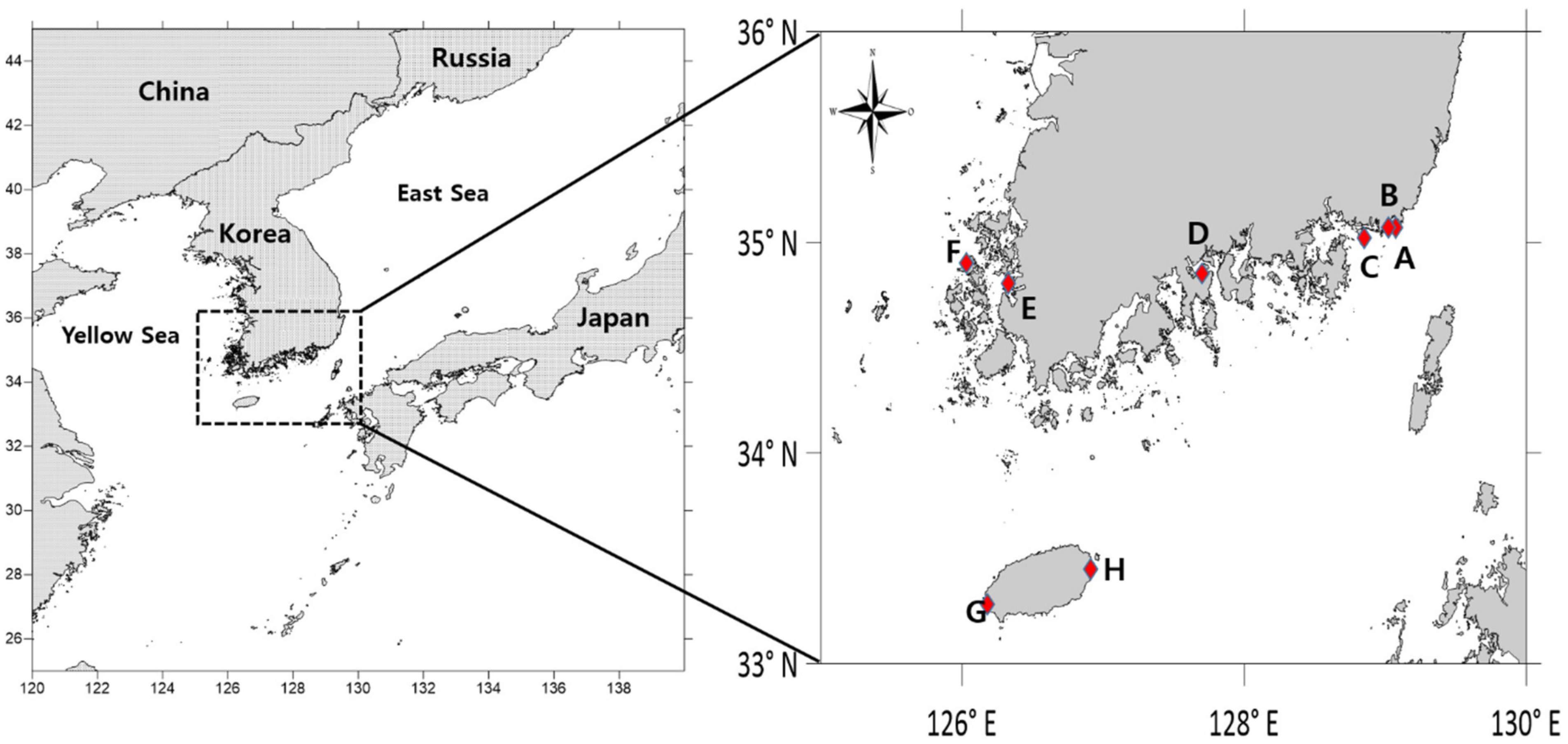
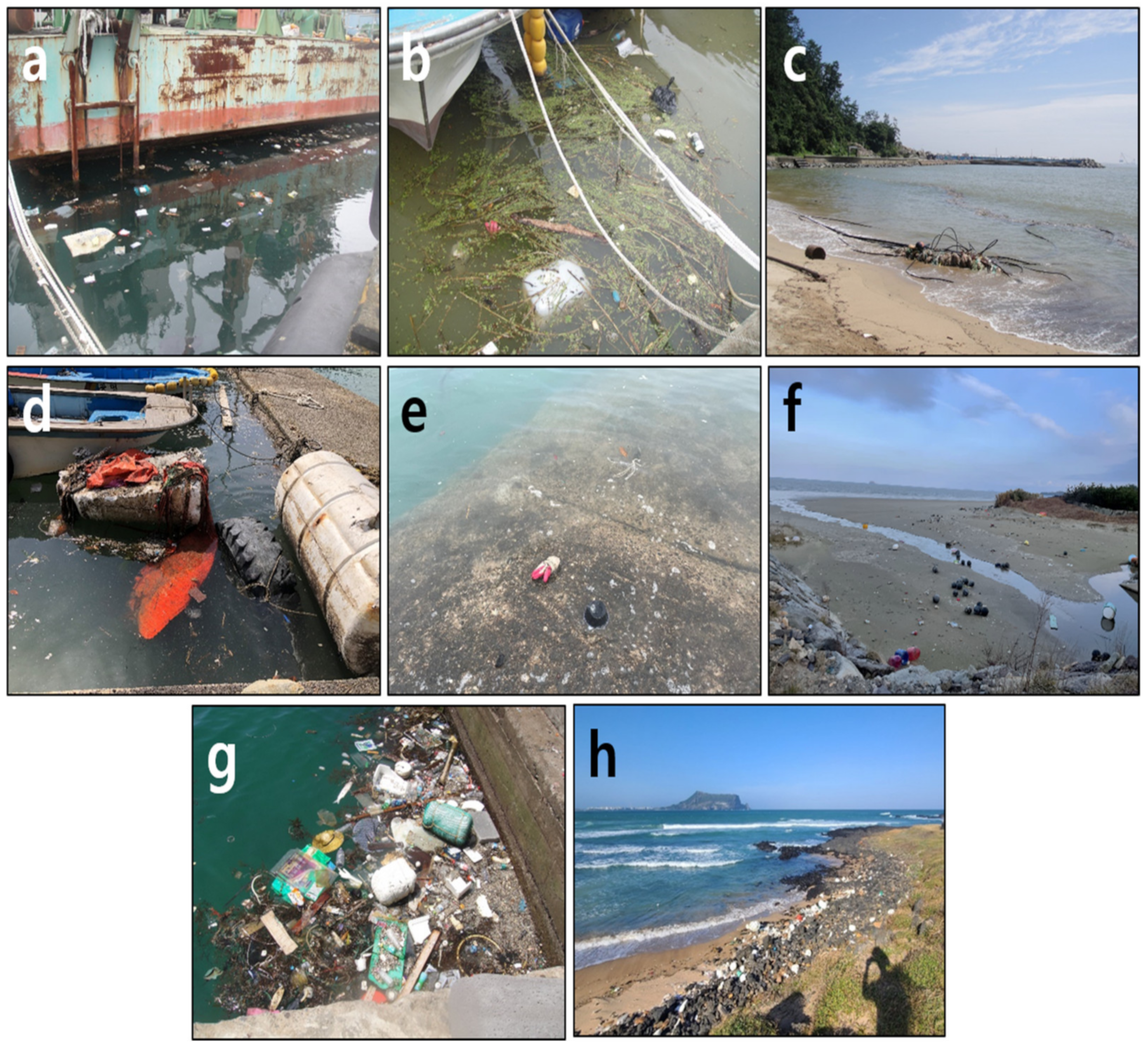
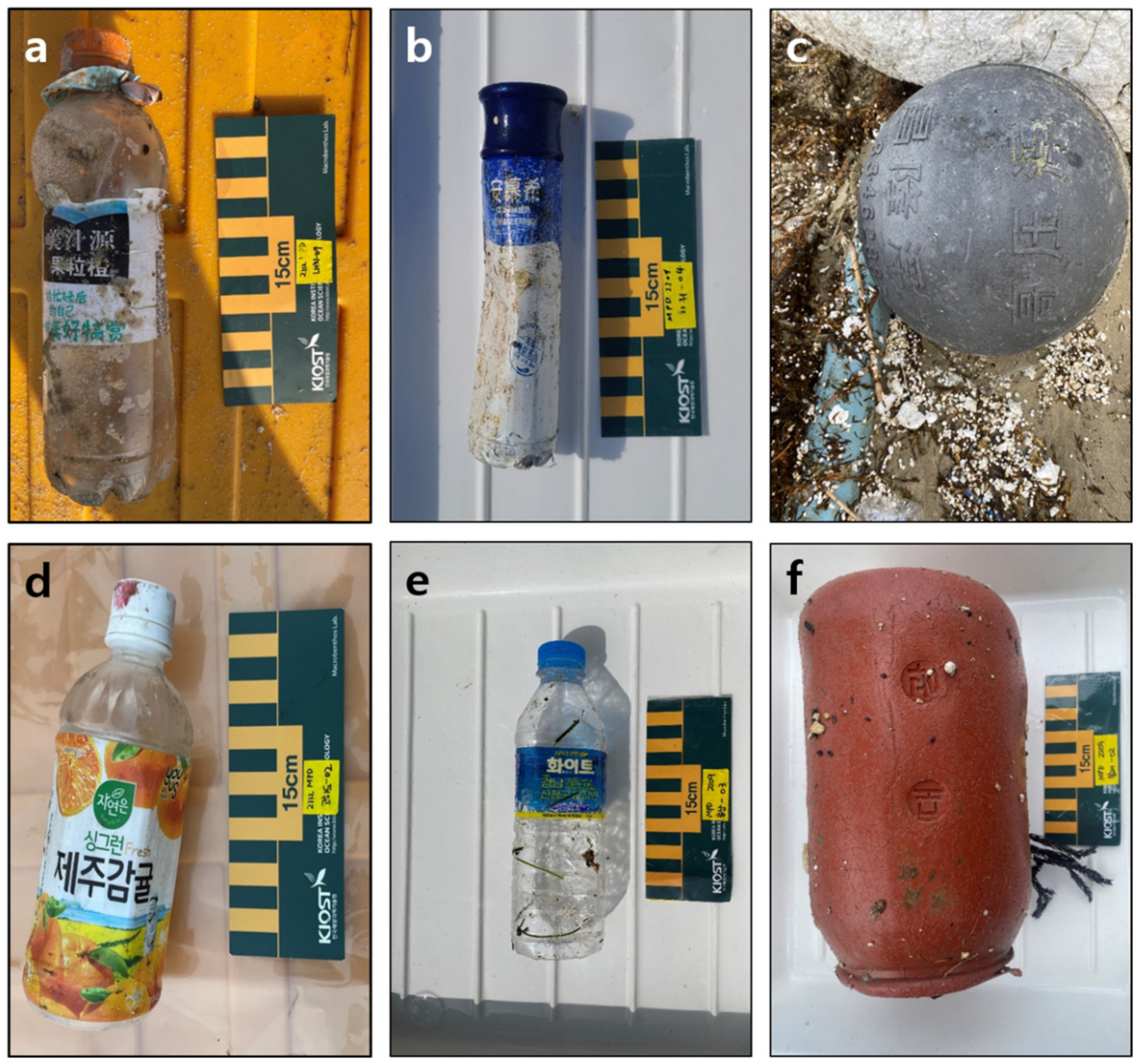

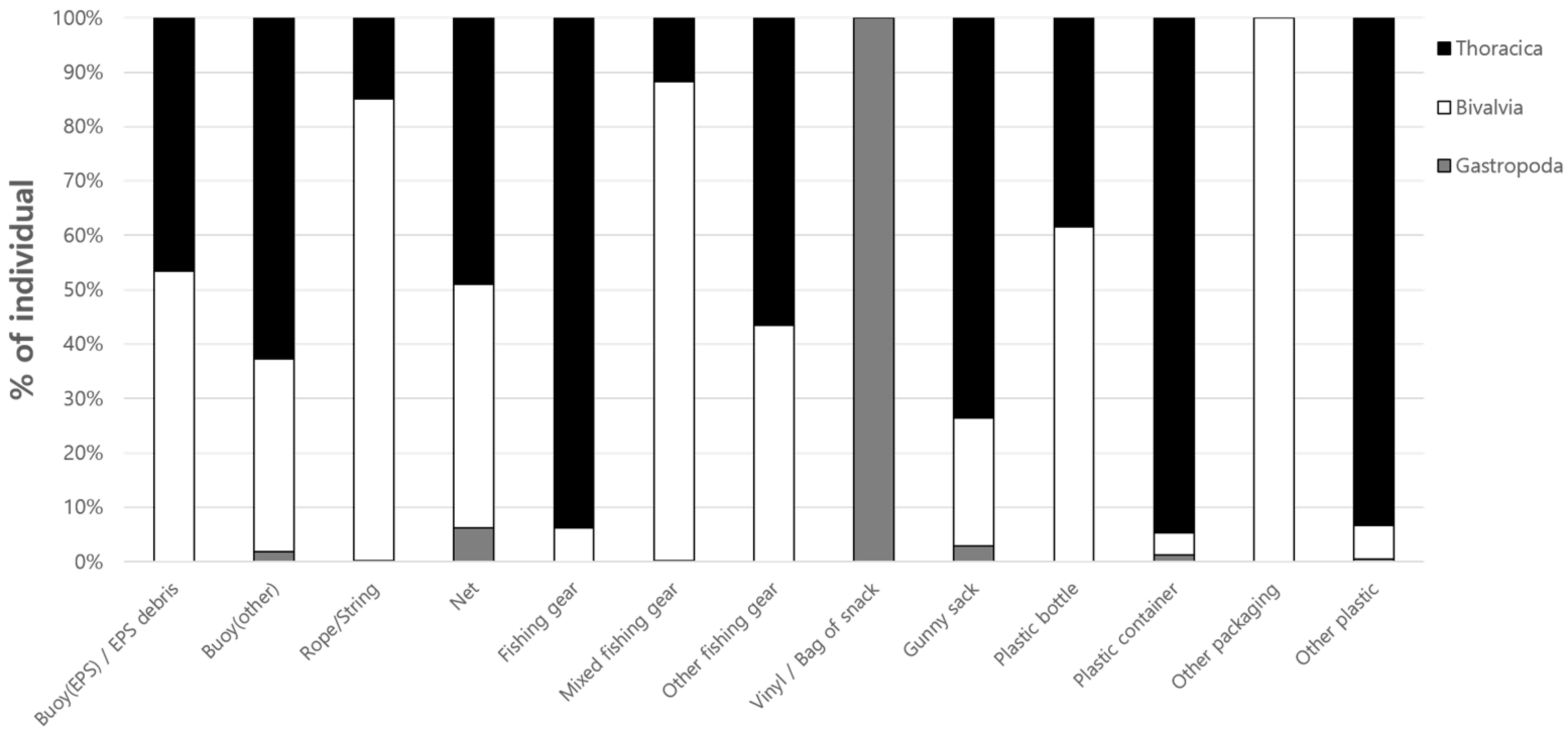
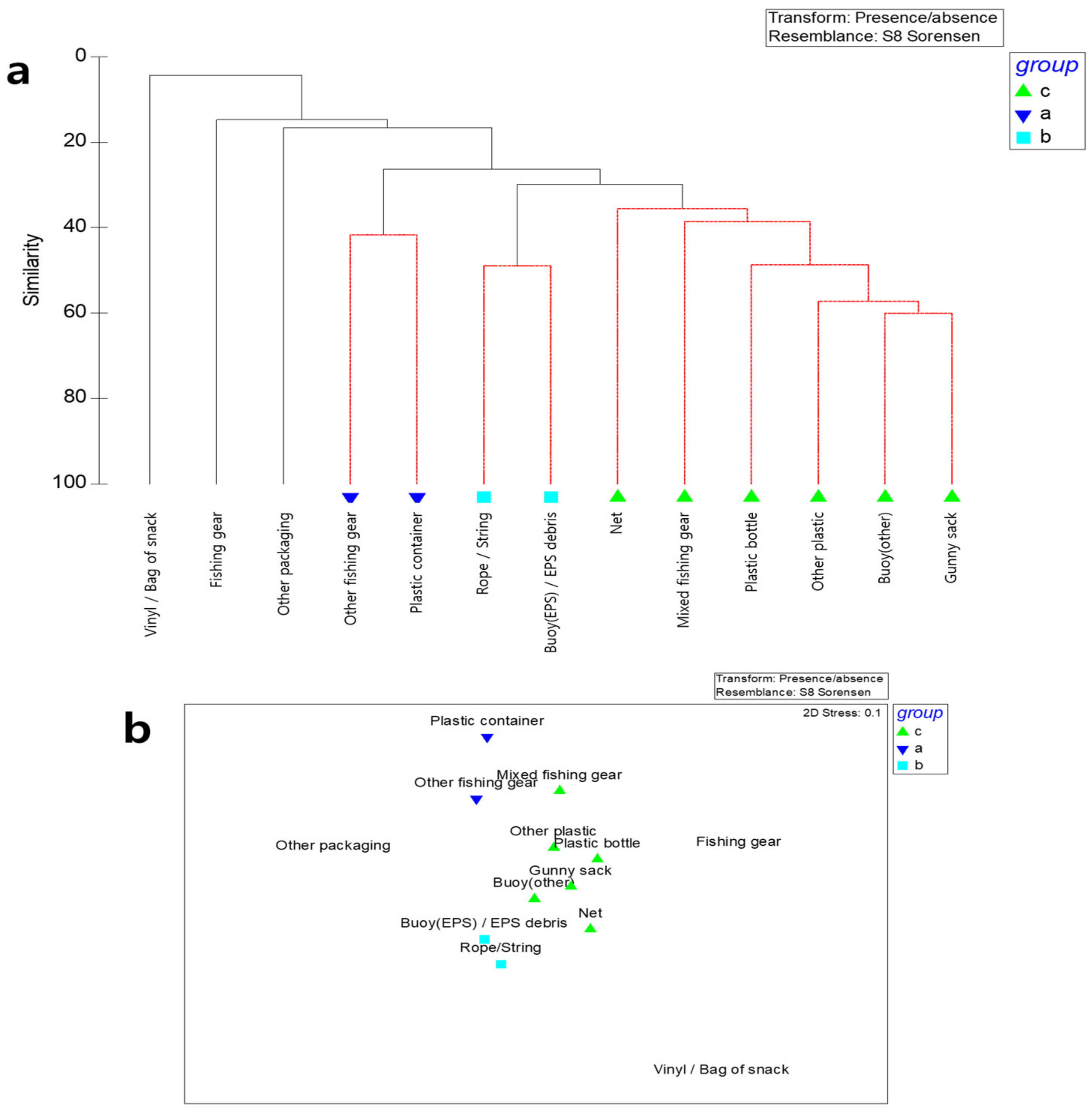
| No. | Area | Sampling Site | Latitude | Longitude |
|---|---|---|---|---|
| 1 | Busan | Bongrae Port | 35° 05.096 | 129° 02.432 |
| 2 | Nakdong river estuary | Myeongji Port | 35° 06.412 | 128° 55.758 |
| 3 | Geoje | Heungnam Beach | 36° 57.657 | 130° 43.049 |
| 4 | Gwangyang | Myodo Port | 34° 52.272 | 127° 42.721 |
| 5 | Mokpo | Gohado Port | 34° 45.934 | 126° 22.373 |
| 6 | Shinan | Naechi Beach | 34° 53.292 | 126° 00.148 |
| 7 | Jeju Island | Yongsu port | 33° 19.431 | 126° 09.948 |
| 8 | Jeju Island | Shinyang seopji beach | 33° 26.123 | 126° 55.59 |
| Material | Domestic (Items) | Foreign-Origin (Items) | Total Items | ||
|---|---|---|---|---|---|
| Plastic debris | Fishing/Aquaculture (Sea-originating MPD) | Buoy (EPS)/EPS debris | 31 | 31 | |
| Buoy (other) | 14 | 8 | 22 | ||
| Rope/String | 37 | 37 | |||
| Net | 16 | 16 | |||
| Fishing gear | 4 | 4 | |||
| Mixed fishing gear | 6 | 6 | |||
| Other fishing gear | 8 | 8 | |||
| Packaging (Land-originating MPD) | Vinyl/Bag of snack | 5 | 5 | ||
| Gunny sack | 9 | 9 | |||
| Plastic bottle | 16 | 6 | 22 | ||
| Plastic container | 11 | 11 | |||
| Other packaging | 8 | 8 | |||
| Other plastic | 16 | 1 | 17 | ||
| Total items | 184 | 15 | 199 | ||
| Rank | Taxa | Species | Frequency of Appearance (%) |
|---|---|---|---|
| 1 | Bivalvia | Mytilus galloprovincialis | 20.6 |
| 2 | Thoracica | Amphibalanus improvisus | 15.1 |
| 3 | Thoracica | Lepas anatifera | 10.6 |
| 4 | Thoracica | Fistulobalanus albicostatus | 7.0 |
| 5 | Thoracica | Lepas anserifera | 6.5 |
| Rank | Taxa | Species | Frequency of Appearance (%) |
|---|---|---|---|
| Buoy (other) | |||
| 1 | Bivalvia | Mytilus galloprovincialis | 8.7 |
| 2 | Thoracica | Fistulobalanus kondakovi | 6.5 |
| 3 | Thoracica | Lepas anatifera | 6.5 |
| 4 | Thoracica | Lepas anserifera | 6.1 |
| 5 | Thoracica | Amphibalanus improvisus | 5.4 |
| Rope/String | |||
| 1 | Thoracica | Amphibalanus improvisus | 6.1 |
| 2 | Bivalvia | Mytilus galloprovincialis | 4.9 |
| 3 | Bivalvia | Xenostrobus securis | 3.1 |
| 4 | Thoracica | Fistulobalanus kondakovi | 2.5 |
| 5 | Thoracica | Fistulobalanus albicostatus | 1.2 |
| Net | |||
| 1 | Thoracica | Amphibalanus improvisus | 3.8 |
| 2 | Thoracica | Fistulobalanus albicostatus | 3.8 |
| 3 | Bivalvia | Mytilus galloprovincialis | 3.8 |
| 4 | Bivalvia | Xenostrobus atratus | 1.9 |
| 5 | Bivalvia | Xenostrobus securis | 1.9 |
| Year | Area | Sampling Site | Sampling Season | Taxa | Dominant Species | Reference |
|---|---|---|---|---|---|---|
| 1993–1994 | Southern Coast | Chagwido (Jeju) | All seasons | Gastropoda | Nodilittorina exigua | [48] |
| 1998 | Southern Coast | Yeosu | All seasons | Thoracica | Chthamalus challengeri | [52] |
| 2000–2001 | Southern Coast | Songacksan (Jeju) | All seasons | Gastropoda | Nodilittorina exigua | [49] |
| 2003–2004 | Western Coast | Uldolmok (Jindo) | Spring, Autumn | Thoracica | Chthamalus challengeri | [50] |
| 2009–2011 | Eastern Coast | Dokdo | All seasons | Gastropoda | Cellana toreuma | [47] |
| 2011 | Eastern Coast | Ulju | All seasons | Bivalvia | Mytilus edulis | [51] |
Disclaimer/Publisher’s Note: The statements, opinions and data contained in all publications are solely those of the individual author(s) and contributor(s) and not of MDPI and/or the editor(s). MDPI and/or the editor(s) disclaim responsibility for any injury to people or property resulting from any ideas, methods, instructions or products referred to in the content. |
© 2023 by the authors. Licensee MDPI, Basel, Switzerland. This article is an open access article distributed under the terms and conditions of the Creative Commons Attribution (CC BY) license (https://creativecommons.org/licenses/by/4.0/).
Share and Cite
Han, G.H.; Kim, S.L.; Kang, S.M.; Lee, H.-G.; Yu, O.H. Attached Macroinvertebrates Inhabiting Marine Plastic Debris from the Beach and Port Areas of the Southern Sea of Korea. J. Mar. Sci. Eng. 2023, 11, 252. https://doi.org/10.3390/jmse11020252
Han GH, Kim SL, Kang SM, Lee H-G, Yu OH. Attached Macroinvertebrates Inhabiting Marine Plastic Debris from the Beach and Port Areas of the Southern Sea of Korea. Journal of Marine Science and Engineering. 2023; 11(2):252. https://doi.org/10.3390/jmse11020252
Chicago/Turabian StyleHan, Gwan Hee, Sang Lyeol Kim, Su Min Kang, Hyung-Gon Lee, and Ok Hwan Yu. 2023. "Attached Macroinvertebrates Inhabiting Marine Plastic Debris from the Beach and Port Areas of the Southern Sea of Korea" Journal of Marine Science and Engineering 11, no. 2: 252. https://doi.org/10.3390/jmse11020252
APA StyleHan, G. H., Kim, S. L., Kang, S. M., Lee, H.-G., & Yu, O. H. (2023). Attached Macroinvertebrates Inhabiting Marine Plastic Debris from the Beach and Port Areas of the Southern Sea of Korea. Journal of Marine Science and Engineering, 11(2), 252. https://doi.org/10.3390/jmse11020252






